If you are teaching a data science or analytics focused course, we would like to highlight the advantages of using KNIME Analytics Platform as a teaching tool: for example its extensive range of data science techniques, visual programming, the open source and free software, and the supportive community. Furthermore, we would like to introduce you to the KNIME Academic Alliance - a program that was set up in order to support educators and researchers, offering access to free materials and concepts on how to integrate KNIME software in your classes.
With a wide range of data access and processing functions, modeling tools, and techniques all within a single platform, KNIME software is suitable for teaching all kinds of topics on the data science curriculum: From machine learning to data wrangling, deployment to text mining, image processing to time series analysis, and many more. As a visual programming environment, KNIME Analytics Platform is easier to grasp in comparison to the syntactic nature of programming languages. This allows you to focus on teaching the math, the concepts, and the algorithms rather than a programming language. While removing the programming barrier, the flexibility of the machine learning algorithms and the data science techniques is preserved.
KNIME Analytics Platform is open source and free to use, which is always appreciated by students in the classroom: Such tools can accompany them throughout the rest of their career.
A supportive, competent, and active community is supported by five pillars:
- KNIME Hub as the public workflow repository
- KNIME Forum as the place to go for questions and receive technical help, with a dedicated space for educators in academia
- KNIME Press as the bookstore for KNIME software related books
- KNIME learning resources
- KNIME Certification Program for professional titles in the job market
1. Create your own KNIME account
Membership to the KNIME Academic Alliance starts with a KNIME account. A KNIME account is a general resource that allows you to access the KNIME Forum, KNIME Hub, and all protected material. If you do not already have one, just create a new KNIME account.
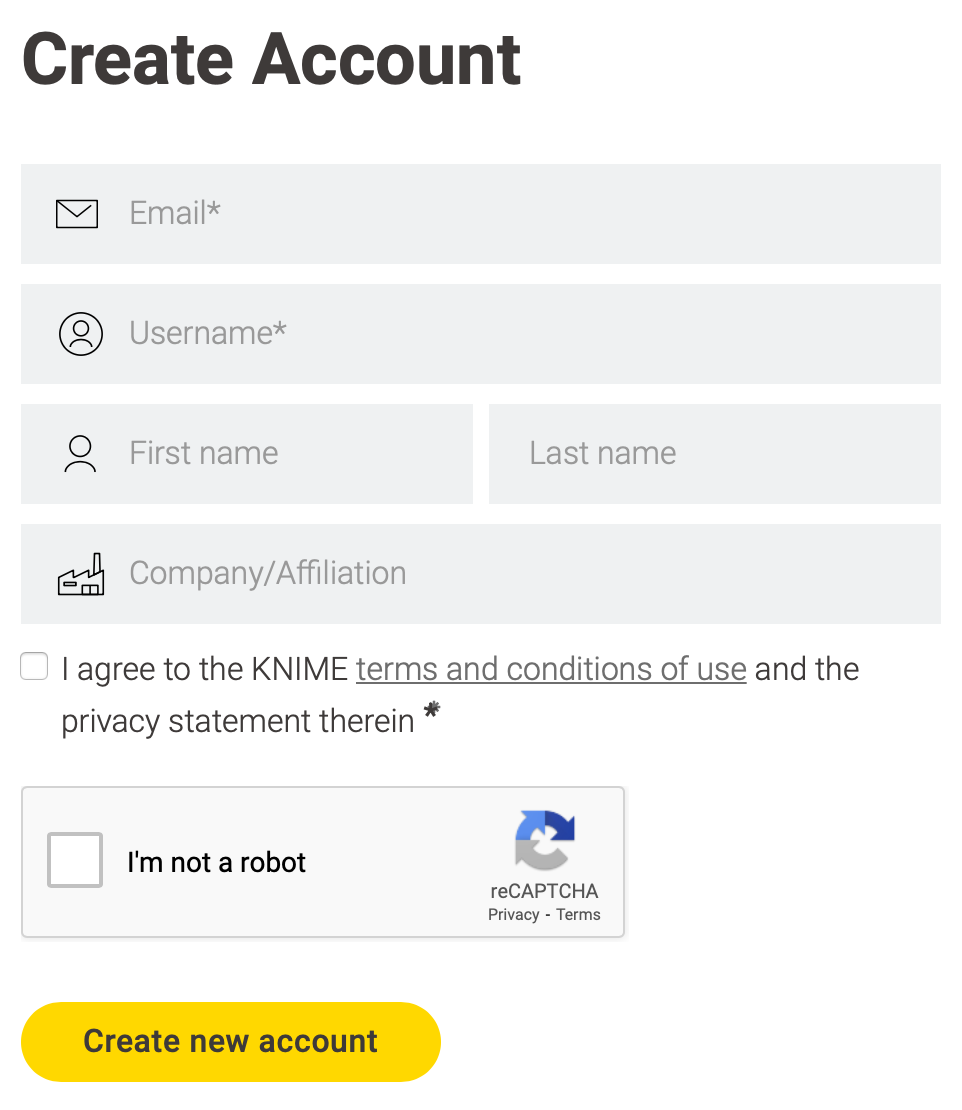
The account alone however does not allow you to access the material from the Academic Alliance program. Your account needs to be enabled by becoming a member of the KNIME Academic Alliance.
2. Become a member of the Academic Alliance
If you are a lecturer, a faculty member of a higher education institution, or a researcher, you are eligible to become a member of the KNIME Academic Alliance. Send a request to academia@knime.com with:
- Your previously created KNIME account name or the associated email address
- Affiliation (university or institution)
- Courses that you are teaching or planning to teach
As a member of the Alliance you will also receive quarterly updates about the program via email.
3. Download getting started materials
Whatever the course you are running, if you want to integrate KNIME Analytics Platform you will need a short tutorial at the beginning of your class.
The Getting Started with Teaching page contains material to help you run the best tutorial, for the latest up to date software and without omitting any important information. An outline and demo slides can be downloaded from this page.
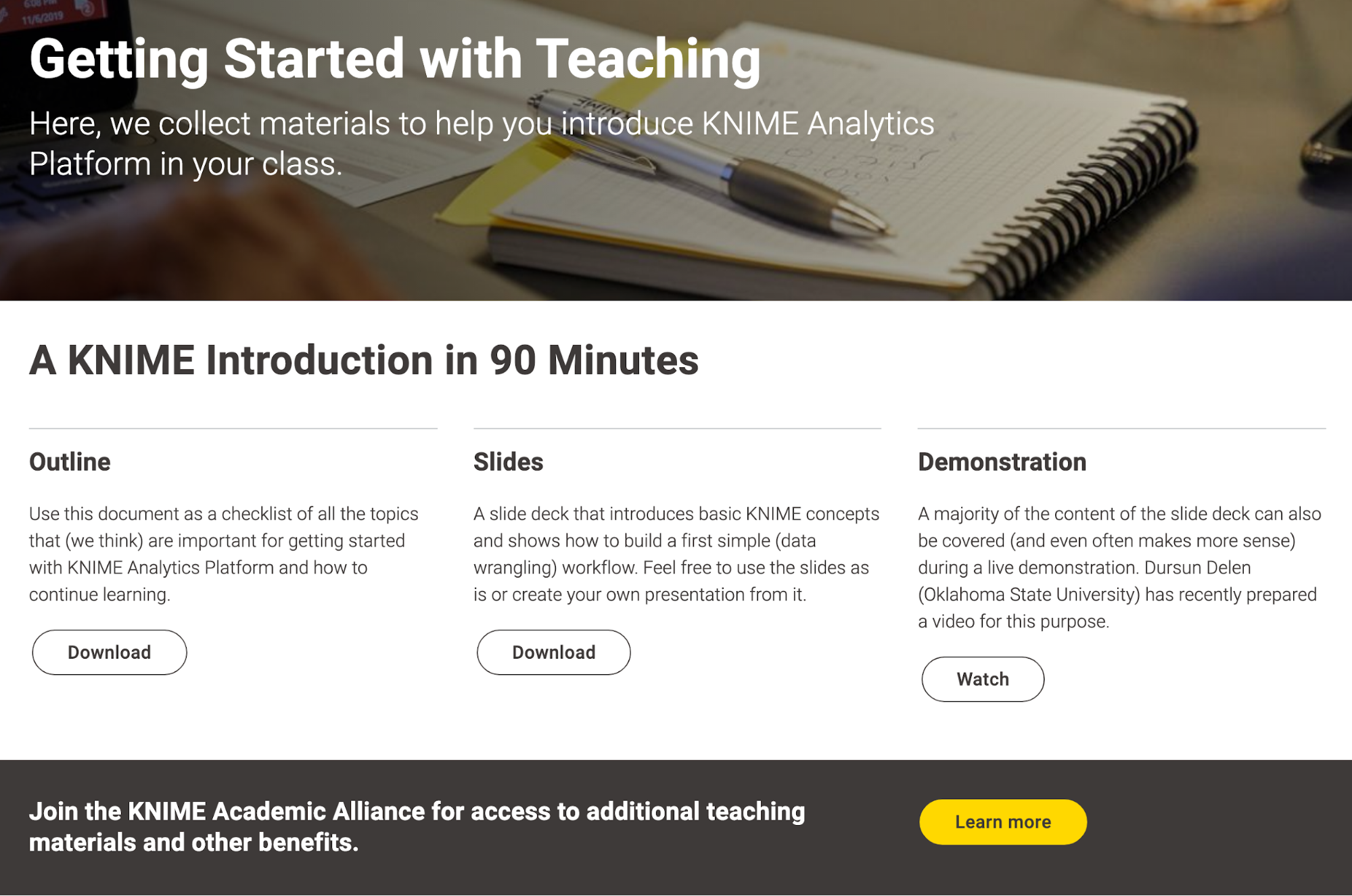
4. Download teaching materials
The Teaching Materials page (access requires you to have completed steps 1-3) contains the agenda, slides, and exercises we use in KNIME courses for machine learning, text mining, time series analysis, life sciences, and data visualization. When available, it also contains references to entire academic courses covering 10 to 20 lessons. This is the case, for example, for the Machine Learning material, including a reference to the lessons made available by Prof. Michael Berthold from his course “Machine Learning and AI for Data Science” run at the University of Konstanz during the winter term 2020/2021. All available material has been tested and is regularly updated.
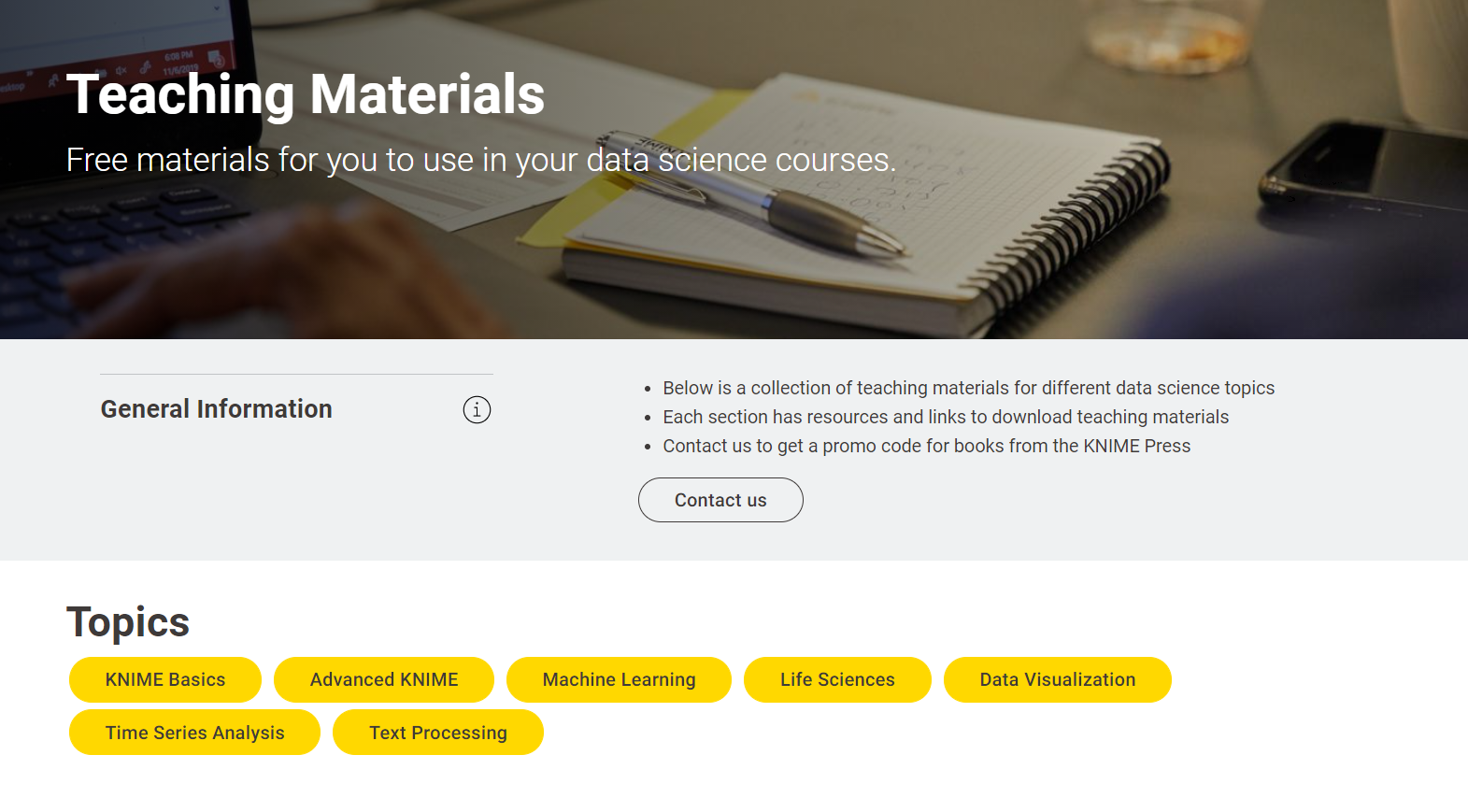
This next screenshot (Fig. 4), for instance, shows you the typical range of educational materials available in the Machine Learning section of the Teaching Materials webpage.
While these materials can be used as is, you can also use them as a starting point and make them your own (since they are released under CC BY-NC-SA 4.0). Once you have adapted the materials to your needs, you can share them with the students on KNIME Hub.
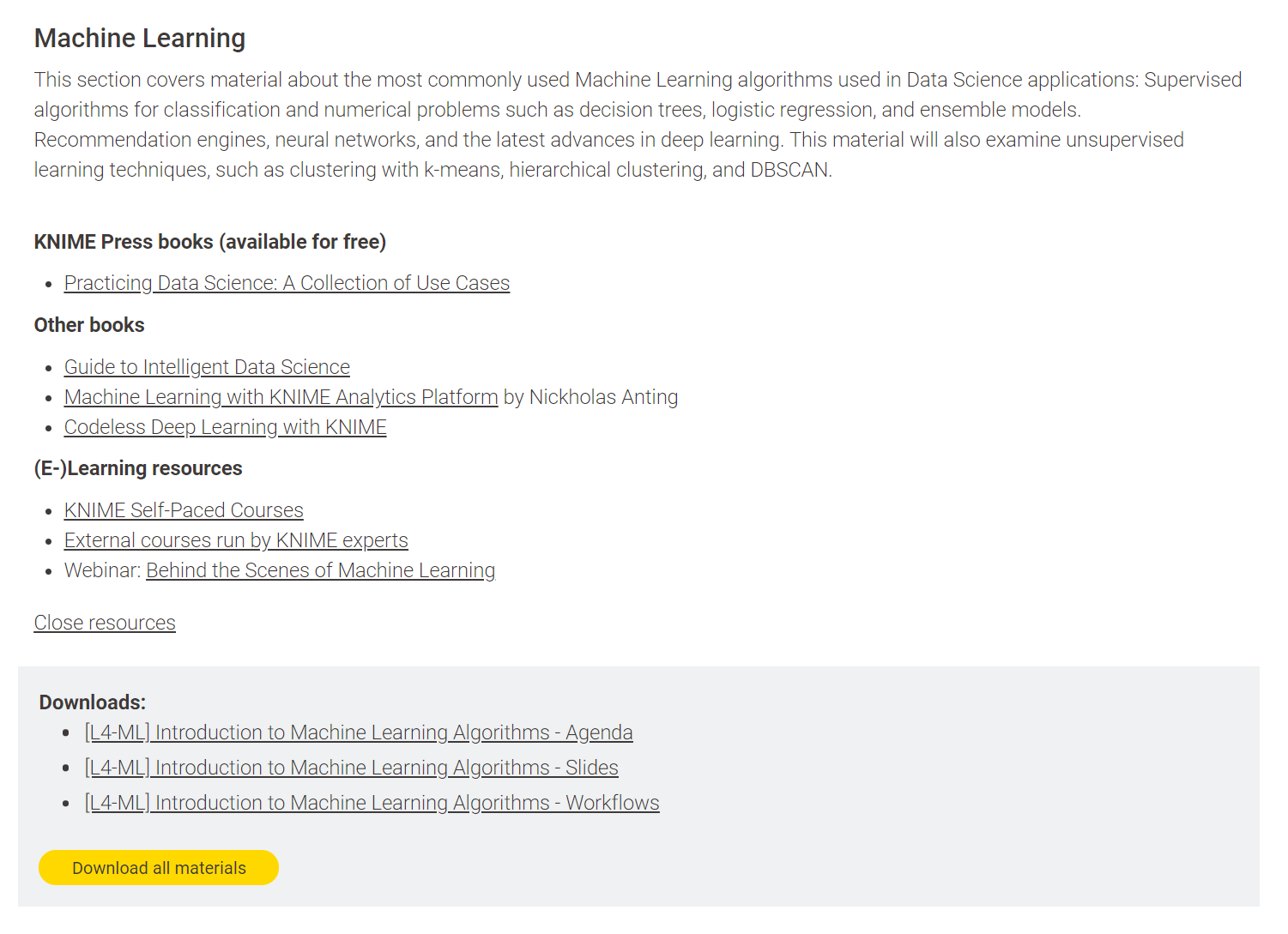
5. Collaborate on KNIME Hub
KNIME Hub is a useful resource to find not only workflows, components, and extensions, but also to collaborate. So-called “Spaces” are available for you to host and share material, such as examples, assignments, and solutions.
By default, you have two spaces available on KNIME Hub: a private space to park your work and a public space to share material. You can go on to create multiple private or public spaces. A public space could be used to share material with the students in a class. You can create a new space on the KNIME Hub from your Spaces page on the KNIME Hub. See the About webpage on the KNIME Hub to see how this is done.
In Figure 6, below, you can see the exercise workflows used for the Introduction to Machine Learning course at the University of Konstanz, which have been hosted in a dedicated space named Public Exercises by the user emilio_s and organized in a number of subfolders.
Notice that other instructors (shown in the top right corner) have been granted permission to read, download, change, and update material in this space.
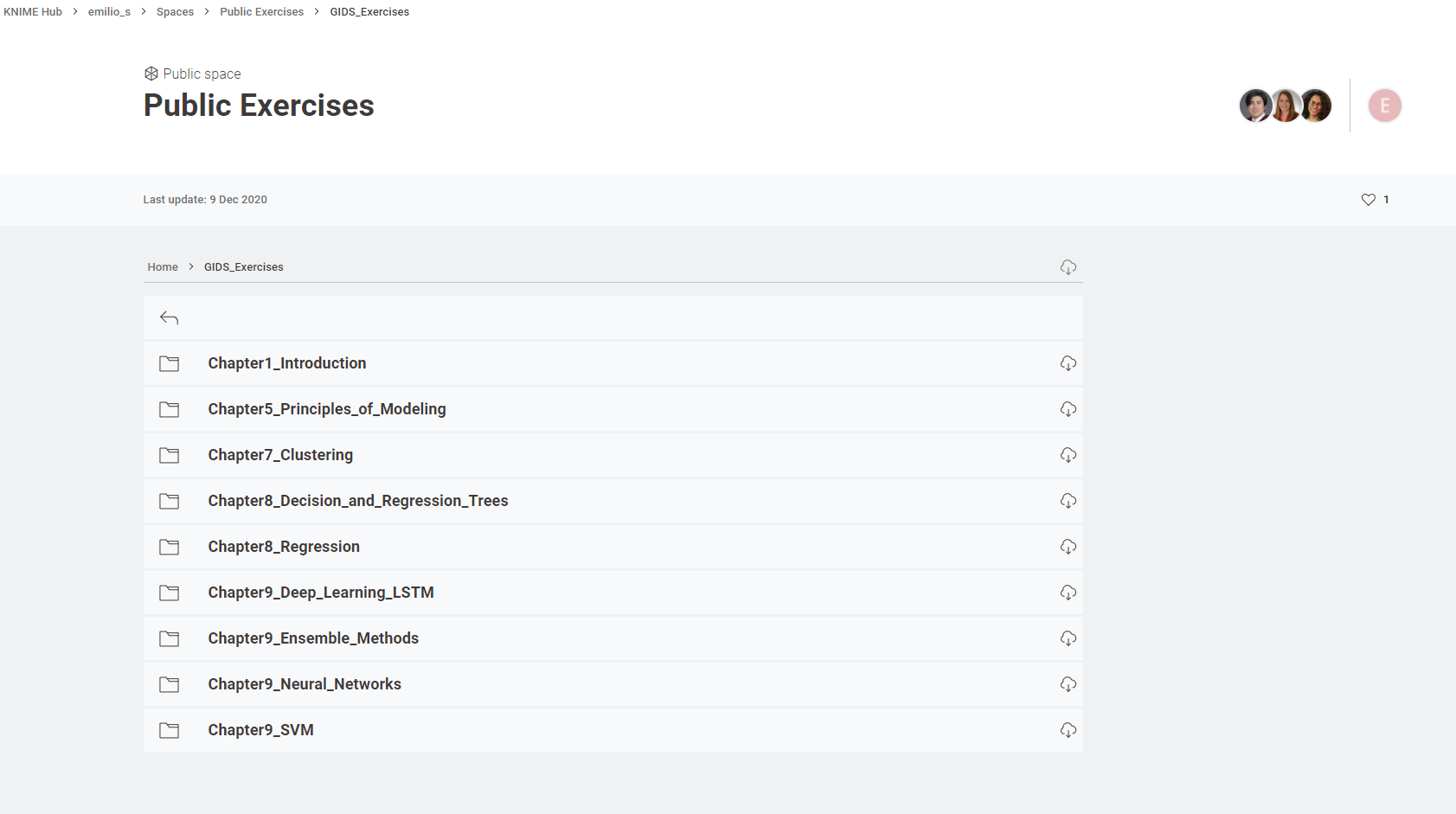
6. Access additional resources
As if the teaching material listed above, for all those courses and with all those lessons, were not enough, membership to the Academic Alliance program gives you access to a number of additional free resources for your students. Let’s start the list.
- Promotion code for free e-books from the KNIME Press (see Fig. 7)
- Discounted or even free seats on selected KNIME courses
- Enrollment in KNIME self-paced courses
- Guest lectures, like for example a KNIME Learnathon for beginners or for expert KNIME users
- A complimentary KNIME Server license for education and research
For any of the additional resources, just send us a detailed request at academia@knime.com.

7. Discuss challenges and share best practices
The KNIME Forum includes a KNIME Academic Alliance category where you can explore contributions posted by other members and upload your own.
Indeed, if you’re just starting out using KNIME Analytics Platform in your course, this is the right place to ask questions and get answers from peers. You can also like other people’s comments, which helps to highlight the reliability of the answer itself.
If you don’t feel comfortable posting into the community just yet, but you have some burning questions, feel free to reach out to us directly at academia@knime.com.
8. Host a free certification exam for your class
Once you have run a class with KNIME Analytics Platform, wouldn’t it be nice for students to not only have your class in their transcript but also be able to show their newly gained professional expertise on their CV? We make that possible with the KNIME Certification Program, where we offer members of the Academic Alliance the chance to organize a dedicated event for their class.
Wrapping up & next appointment
We conclude here this short review of the KNIME Academic Alliance program and the privileges its membership offers to educators (in higher education). We hope this short introduction has been useful and that you feel motivated to create a KNIME account to explore more of the resources we have described.
While KNIME Analytics Platform itself is a great open source tool to empower students with knowledge on artificial intelligence techniques and to overcome the barrier of coding, we have listed here a few additional resources to facilitate the integration of KNIME in your course(s).
